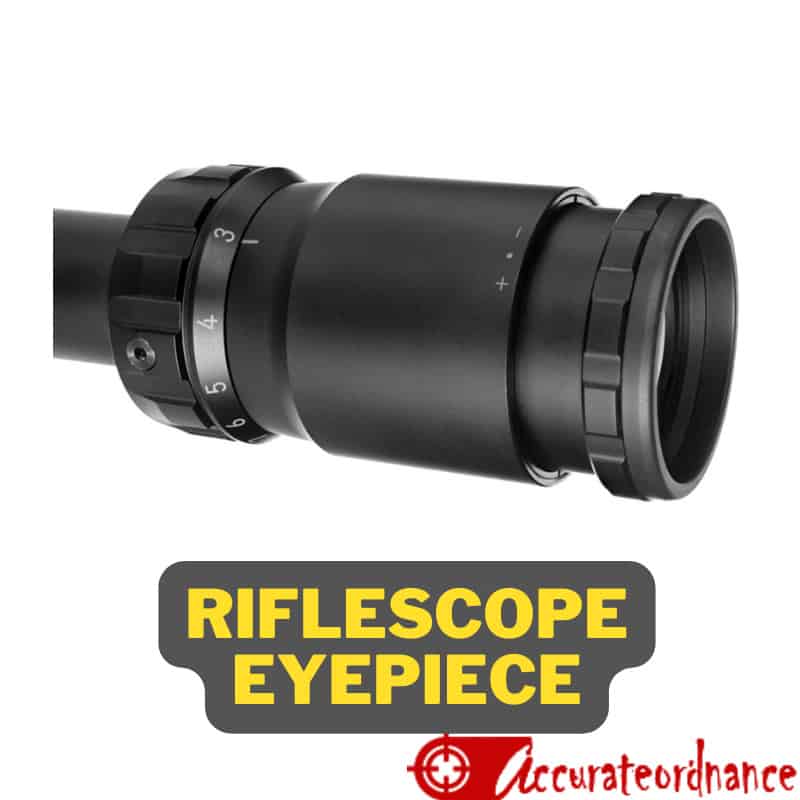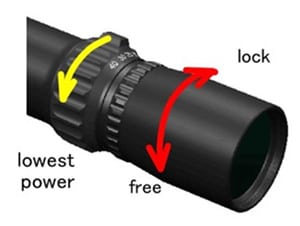Do you need clarification about what an eyepiece focus means? There are so many shooters out there that have been shooting for years and do not know the meaning or essence of a fast-focus eyepiece in a riflescope.

Some even confuse the fast-focus eyepiece with parallax adjustment. Are looking for more information about this topic, jump in, and let’s find out together.
The Eyepiece

The eyepiece of a rifle scope is also known as the ocular lens. A riflescope normally has two major lenses on the outside, the objective lens, and the ocular lens. The objective lens is the end of the scope that is far away from the shooter; in other words, it is the lens that collects light from the target.
The ocular lens or eyepiece, on the other hand, is that part of a rifle scope that is closest to the shooter’s eye when looking through the scope.
Fast Focus Eyepiece
The fast-focus eyepiece is the adjustable part of the eyepiece that can be used to make the shooter see the reticle clearly. People have different eye capabilities or eye problems. Some people use glasses, and others do not. A person that uses glasses will not see the reticle the same way as a person that does not use a glass.
Since we all have different eye capabilities, it is important that we each set our riflescopes to match our eye ability. The focus eyepiece helps a shooter to see the reticle in a crisp and clear way.
Step-by-Step Guide to Adjusting the Eyepiece
After mounting your scope, you want to ensure that the reticle is very sharp when you look through the scope. As a result, you might have to adjust the diopter setting of the scope.
When you want to adjust the eyepiece for your scope, there are some steps you must follow, and they are explained below:

If you use prescription glasses for your shooting, it is best to wear them before you start adjusting the eyepiece because after setting the diopter and focusing the reticle, using any additional eye aid before shooting will alter the sharpness of the reticle.
If your riflescope has a lock ring, rotate the body counter-clockwise until the knurled locking knob on the eyepiece slides freely. This is to help you gain access to the diopter setting so you can make the adjustment easily. If your scope has a fast focus adjustment and it does not have a lock mechanism, then you can proceed to the next step.
The next step is to look at the reticle in the scope while it is pointed to a blank surface. It is preferable to look at the sky or at a white wallpaper. Do not look directly at the sun, as this could cause you some eye damage.
You might ask, why can’t I focus the eyepiece by pointing it at a tree or a target animal? The answer is simple; you would not be able to see the reticle clearly when you point it at a target because your eyes will be forced to focus on the target instead of the reticle which you are trying to look at.
When looking through the scope, ensure that you don’t look at the reticle for an extended period. It is advisable to look at the reticle for a maximum of 3 – 5 seconds. If you look at the scope for more than 5 seconds, your eyes will automatically start correcting the sharpness of the reticle. Our goal is to get the sharpest reticle image at first glance and not to force the eyes to adapt and adjust the image.
After taking short glances at the reticle, rotate the diopter setting by turning it slightly and looking through it again. Keep repeating this step until you get a very sharp image. After getting a sharp image, continue turning the diopter setting until the reticle becomes blurry. This is done so that you can know the point at which the image enters or goes out of focus. When you reach the out-of-focus point, return the settings back a little until you get the sharp reticle image again.
When trying to adjust the fast-focus eyepiece, ensure you make this adjustment at the lowest magnification of your riflescope. So if you are using a 1-9x magnification scope, ensure the eyepiece is set at the 1x magnification. Setting the diopter at the lowest magnification will help you maintain the sharpness of the reticle as you increase magnification.
Most riflescopes have a diopter setting that ranges from -2 to +2. If you are shortsighted, you have to spin the eyepiece counterclockwise toward the ( – ) direction. But if you are farsighted, you’ll need to turn it clockwise ( + ).
If your scope has a lock ring for the eyepiece, go ahead and lock it, if it doesn’t then try to be careful so the diopter setting does not change. Once you have set the eyepiece to the ideal position for your eyesight, do not modify the diopter settings again except if your visual acuity changes.
You are now ready to sight your targets with the eyepiece!
Fast Focus Eyepiece Vs Locking Ring Focus Eyepiece
I once received a question about the difference between a fast focus and a locking focus eyepiece. Here it is.
QUESTION
I’m about to get a new riflescope in the next few days, and I have one significant question for you. I’m used to old scopes with a locking ring for adjusting the focus. But I found that most of the recent riflescopes come with a fast focus adjustment at the eyepiece end of the scope. What is the advantage of a “fast focus scope”? I used to believe that after focusing a scope, it shouldn’t be tampered with again. How simple is it to knock the scope out of focus while moving through a heavy bush or taking the scope into and out of the case?
ANSWER
To begin with, I have spoken with many shooters, and most of them believe that the classic lock ring type of focus is superior to the fast focus eyepiece since the fast focus eyepiece could be easily pulled out of alignment accidentally. It appears to be so, and in certain cases, it is very correct. However, I have never had a case of distorted fast focus since I have been using them. Maybe I was more careful, but the point is that it happens rarely.


I can think of two major advantages of the fast-focus eyepiece. Firstly, as you become older, your eyesight may change from day to day; as a result, you might notice unclear reticles as you try to aim at a target. At this point, you might have to quickly adjust the eyepiece focus so you can see both your target and the reticle clearly. A fast-focus eyepiece makes this simple and convenient.
Secondly, a fast-focus eyepiece may be used to sharpen the image at near or far distances from a parallax-free range. In simple terms, the fast focus can be used to make the image clearer. When you adjust the fast focus, in this case, the reticle will be somewhat defocused. However, it will allow the shooter to quickly focus on the target image and then fast refocus the reticle.
The perk of using a fast-focus eyepiece is that the diopter can be changed more quickly since the diopter location changes with an instant eyepiece rotation. When a riflescope is used by the same individual, there’s no need to adjust the eyepiece on a regular basis. However, if it would be used by multiple shooters, then there’ll be a need for a fast focus eyepiece adjustment.
Distinguishing Fast Focus from Parallax
Fast focus is not the same as parallax adjustment. It will have no impact if you try to use the fast focus to correct parallax. The eyepiece focus, whether fast or slow, is used to focus the clarity of the reticle. It can also be used to focus on images that are close or far away for improved clarity; however, since parallax is produced when the image and reticle are in separate planes, the fast-focus eyepiece has no effect on that.
FAQ
What is another name for an eyepiece lens?
Another name for an eyepiece lens is an ocular lens. It is the lens closest to the shooter’s eye.
What is a parallax adjustment?
A parallax adjustment changes the parallax of the riflescope. It is usually done with a side focus knob at the left hand of the scope. The purpose of the adjustment is to make the reticle stable and sharper in relation to the image and with less apparent movement when firing at different distances.
What does a scope’s diopter adjustment do?
The diopter may be adjusted using the focus button or eyepiece. The reticle on riflescopes may be focused to ensure sharpness using the diopter adjustment.

Mike Hardesty is a published freelance gun writer. He also possesses specialized expertise in rifle scopes With dozens of articles and reviews published in Pew Pew Tactical, Snipercountry.com, and TTAG (The Truth About Guns), Mike is considered a firearms expert. His special area of expertise is handguns.
Mike is a long-time shooter. He has been punching paper targets, taking deer and other game and shooting at competitions since about 1975. Other related pursuits include reloading and bullet casting. He currently reloads for over 10 calibers, both handgun and rifle. His reloads, particularly for 9mm, were in great demand during the height of the ammo shortage among family and friends. He donated hundreds of rounds to informal shooting sessions. He was quoted as saying “I do not sell my reloads but I sure will help my guys shoot ’em for free!”. He has a few cherished firearms that he has inherited or otherwise procured — those are his favorites.
He earned B.S. and M.S. degrees from Indiana State University in 1974-1975.
He’s a firearm experts and is the founder of mhardesty.com.
